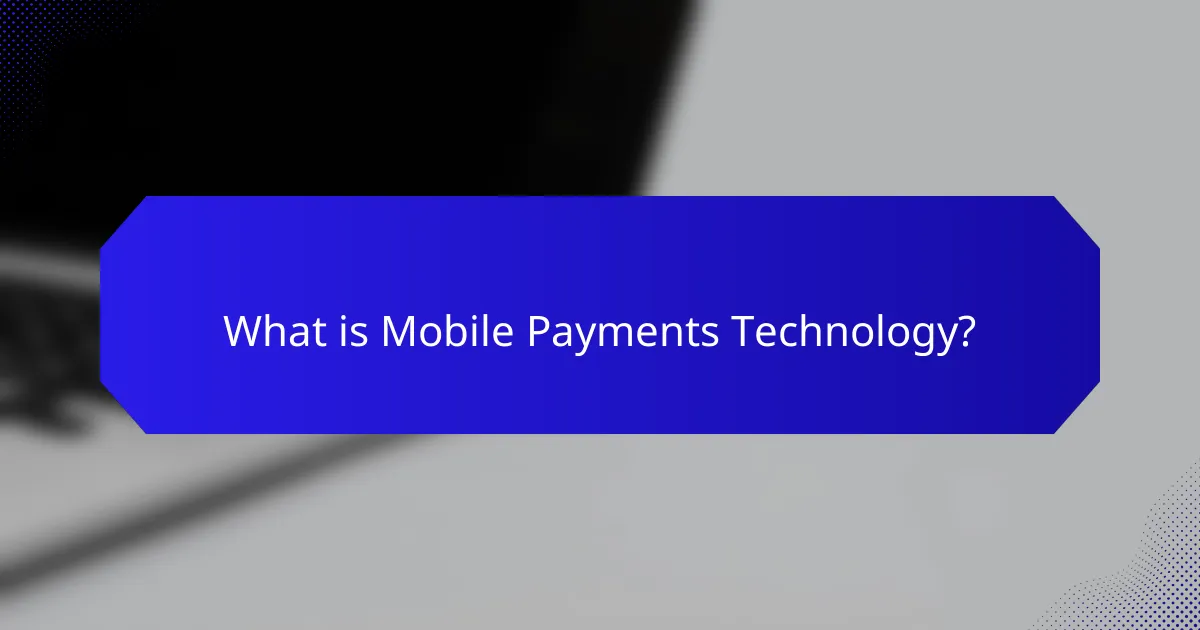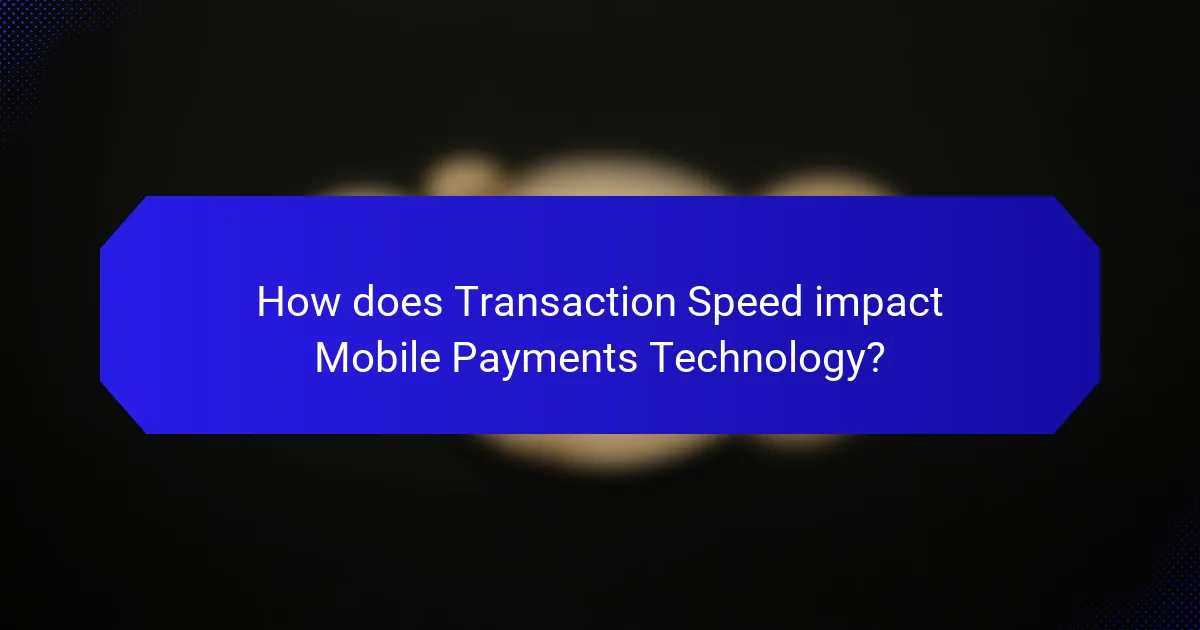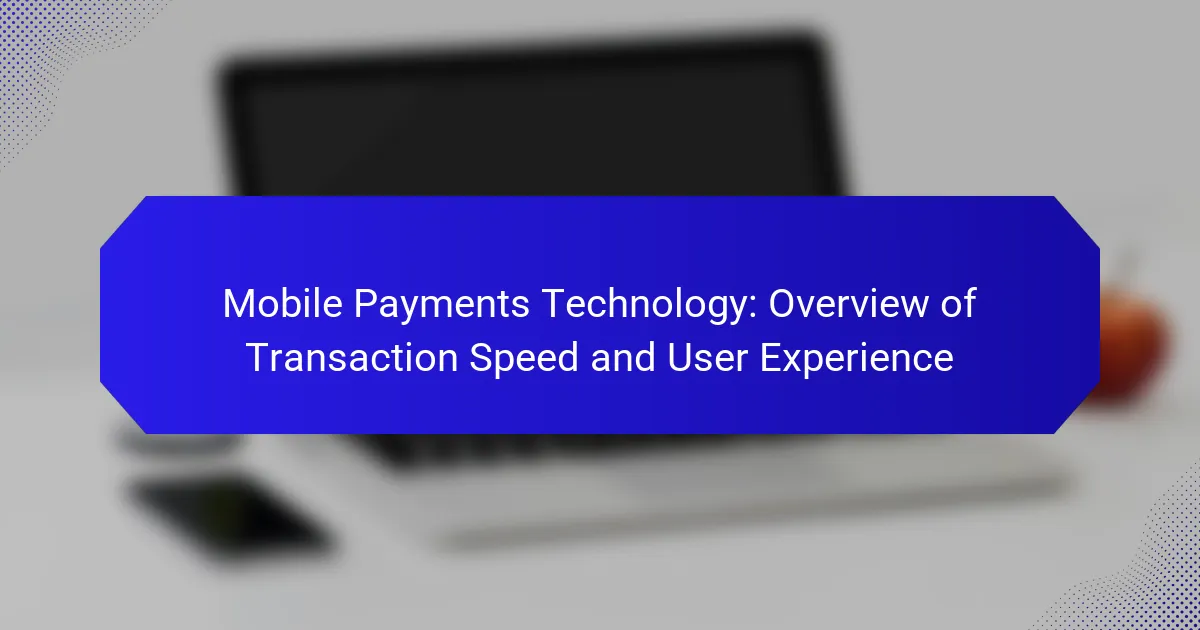Mobile payments technology enables users to conduct financial transactions through mobile devices, utilizing apps, websites, or near-field communication (NFC). The article explores the significance of transaction speed and user experience in this technology, highlighting that mobile payment transactions reached approximately $1.9 trillion globally in 2022. Faster transaction speeds are essential for enhancing customer satisfaction and reducing cart abandonment, particularly in e-commerce. Additionally, a positive user experience, characterized by usability and security features, is critical for the adoption and retention of mobile payment systems. The discussion emphasizes the importance of both speed and user-friendly design in the success of mobile payments technology.

What is Mobile Payments Technology?
Mobile payments technology refers to the system that allows users to make financial transactions using their mobile devices. This technology enables payments to be processed via apps, websites, or near-field communication (NFC). Users can conduct transactions quickly and securely without needing physical cash or credit cards. In 2022, mobile payment transactions worldwide reached approximately $1.9 trillion. This growth demonstrates the increasing adoption of mobile payment methods among consumers and businesses. Mobile payments enhance user experience by providing convenience and speed in transactions.
How does Mobile Payments Technology function?
Mobile payments technology functions by enabling transactions through mobile devices. It utilizes various methods such as Near Field Communication (NFC), QR codes, and mobile wallets. NFC allows devices to communicate when in close proximity, facilitating quick payments. QR codes enable users to scan a code to initiate a payment. Mobile wallets store payment information securely, allowing users to pay without physical cards. Security protocols like tokenization protect sensitive data during transactions. According to a report by Statista, mobile payment transactions are expected to reach $12.06 trillion globally by 2025, highlighting the growing adoption of this technology.
What components are essential to Mobile Payments Technology?
Mobile payments technology relies on several essential components. These components include mobile devices, secure payment gateways, and encryption methods. Mobile devices serve as the primary interface for users to initiate transactions. Secure payment gateways facilitate the communication between the user’s device and the merchant’s payment processor. Encryption methods protect sensitive data during transactions. Additionally, Near Field Communication (NFC) technology enables contactless payments. Digital wallets store payment information securely for easy access. Finally, payment processing networks, such as Visa or Mastercard, ensure transaction approval and settlement. Each component plays a crucial role in delivering a seamless mobile payment experience.
How do these components influence transaction speed?
Transaction speed in mobile payments is influenced by components such as network latency, processing power, and encryption methods. Network latency affects how quickly data is transmitted between devices and servers. Lower latency leads to faster transaction confirmations. Processing power of the device determines how efficiently it can handle payment applications. Higher processing power reduces the time taken for transaction execution. Encryption methods secure transaction data but can also introduce delays. Stronger encryption may slow down processing speed. Overall, optimizing these components enhances transaction speed, improving user experience in mobile payments.
What are the key advantages of Mobile Payments Technology?
Mobile payments technology offers several key advantages. It enables faster transactions, reducing checkout times significantly. Studies show that mobile payments can decrease transaction times by up to 50%. This technology enhances user convenience, allowing payments from anywhere at any time. Security features like encryption and tokenization protect sensitive data during transactions. Additionally, mobile payments provide users with transaction history and budgeting tools. According to a report by Statista, mobile payment users are expected to reach 1.31 billion by 2023, highlighting its growing acceptance. Overall, mobile payments improve efficiency and user experience in financial transactions.
How does Mobile Payments Technology enhance user convenience?
Mobile payments technology enhances user convenience by enabling quick and seamless transactions. Users can make payments using their smartphones without needing cash or physical cards. This technology allows for contactless payments, reducing wait times at checkout. A study by Statista in 2021 indicated that 45% of consumers prefer mobile payments for their speed and ease of use. Additionally, mobile payments often integrate loyalty programs, making it easier for users to earn rewards. The ability to store multiple payment methods in one app simplifies the purchasing process. Overall, mobile payments streamline transactions, improving the overall user experience.
What security measures are in place in Mobile Payments Technology?
Mobile payments technology employs multiple security measures to protect transactions. These include encryption, tokenization, and biometric authentication. Encryption secures data during transmission, making it unreadable to unauthorized parties. Tokenization replaces sensitive information with unique tokens, minimizing data exposure. Biometric authentication uses fingerprints or [censured] recognition for user verification. Additionally, many mobile payment systems implement two-factor authentication for added security. Regular security updates and compliance with standards like PCI DSS further enhance protection. These measures collectively safeguard user information and ensure secure transactions in mobile payments.

How does Transaction Speed impact Mobile Payments Technology?
Transaction speed significantly impacts mobile payments technology by affecting user experience and transaction efficiency. Faster transaction speeds enhance customer satisfaction. They reduce wait times during checkout, leading to a smoother payment process. According to a study by Juniper Research, transactions completed in under 10 seconds increase user retention rates. High transaction speeds also minimize the likelihood of cart abandonment. This is crucial in e-commerce settings where speed is essential. Additionally, improved transaction speeds can support higher transaction volumes. This capability is vital for businesses during peak shopping periods. Overall, transaction speed is a critical factor in the adoption and success of mobile payments technology.
What factors influence the transaction speed of mobile payments?
Transaction speed of mobile payments is influenced by several key factors. Network connectivity plays a critical role; faster internet connections lead to quicker transactions. The payment processing system’s efficiency also impacts speed; streamlined systems reduce processing time. Security measures can slow down transactions; additional verification steps may introduce delays. Device performance is another factor; newer devices generally process transactions faster. Payment method selection affects speed; some methods are inherently quicker than others. Lastly, merchant infrastructure can influence transaction speed; well-optimized systems facilitate rapid processing.
How do network conditions affect transaction speed?
Network conditions significantly influence transaction speed in mobile payments. High latency can delay the communication between devices and servers. Packet loss may lead to retransmissions, further slowing down the process. Bandwidth limitations restrict the amount of data transmitted, impacting speed. A stable and robust network connection enhances transaction efficiency. Conversely, poor network conditions can result in failed transactions. Research shows that transactions over 4G networks are faster than those over 3G. According to a study by the International Telecommunication Union, network quality directly correlates with user satisfaction in mobile payment systems.
What role do payment processing systems play in transaction speed?
Payment processing systems significantly influence transaction speed. They facilitate the transfer of payment information between buyers and sellers. Efficient systems can process transactions in seconds. This speed is crucial for user satisfaction in mobile payments. Delays can lead to abandoned purchases. Payment gateways and processors optimize data routing to minimize lag. Advanced encryption and security measures also impact processing time. Faster systems enhance overall user experience and trust in mobile payment platforms.
Why is transaction speed crucial for user experience?
Transaction speed is crucial for user experience because it directly impacts customer satisfaction and retention. Faster transactions reduce wait times, enhancing convenience for users. Research indicates that 53% of mobile users abandon transactions that take longer than three seconds. Immediate feedback during transactions builds trust and confidence in the payment system. High transaction speeds can lead to increased sales, as users are more likely to complete purchases when the process is quick. In contrast, slow transaction speeds can frustrate users, leading to a negative perception of the service. Overall, transaction speed is a key factor in ensuring a seamless and efficient user experience in mobile payments.
How does transaction speed affect customer satisfaction?
Transaction speed significantly influences customer satisfaction in mobile payments. Faster transactions reduce waiting times, enhancing the overall user experience. According to a study by the Federal Reserve, 70% of consumers prefer quick payment options. Slow transaction speeds can lead to frustration and abandoned purchases. Research shows that a delay of just a few seconds can increase dropout rates by 20%. Customers value efficiency and convenience in mobile transactions. Therefore, optimizing transaction speed is crucial for retaining users and boosting satisfaction.
What are the implications of slow transaction speeds on business operations?
Slow transaction speeds negatively impact business operations. They lead to longer wait times for customers. This can result in decreased customer satisfaction. A study by the Harvard Business Review found that a one-second delay can reduce customer satisfaction by 16%. Slow transactions can also cause lost sales opportunities. Businesses may lose customers who abandon purchases due to delays. Additionally, operational efficiency suffers when transactions take longer. Employees spend more time processing transactions instead of serving customers. This can lead to increased labor costs and reduced productivity. Overall, slow transaction speeds can harm a business’s reputation and profitability.

What is the User Experience in Mobile Payments Technology?
User experience in mobile payments technology refers to how users interact with payment applications and services. It encompasses ease of use, speed, security, and overall satisfaction. A positive user experience is crucial for adoption and retention. Research indicates that 70% of users abandon mobile payment apps due to poor usability. Features like quick transaction times and intuitive interfaces enhance user satisfaction. Security measures, such as biometric authentication, also contribute to a positive experience. In summary, effective mobile payment systems prioritize user-friendly design and robust security to ensure a seamless experience.
How do users perceive the Mobile Payments Technology experience?
Users generally perceive the Mobile Payments Technology experience as convenient and efficient. Many users appreciate the speed of transactions, often completing payments in seconds. A survey by Statista in 2021 indicated that 45% of users prefer mobile payments for their quick processing. Additionally, users value the ease of access, as mobile payments can be made from anywhere with an internet connection. Security is another critical factor; 60% of users express concerns about data safety but feel reassured by encryption technologies. Overall, the combination of convenience, speed, and perceived security shapes a positive perception of mobile payment technology among users.
What are common user pain points in mobile payment transactions?
Common user pain points in mobile payment transactions include security concerns, transaction failures, and usability issues. Users often worry about the safety of their financial information. A survey by Statista found that 30% of users hesitate to use mobile payments due to security fears. Transaction failures can occur due to poor connectivity or app glitches, leading to frustration. Additionally, complex user interfaces can hinder the payment process. Research by Pew Research Center indicates that 20% of users find mobile payment apps difficult to navigate. These factors contribute to a negative user experience in mobile payment transactions.
How can user interface design enhance the mobile payment experience?
User interface design can significantly enhance the mobile payment experience by improving usability and efficiency. A well-designed interface minimizes the number of steps required to complete a transaction. This reduces user frustration and increases the likelihood of successful payments.
Clear visual cues guide users through the payment process. Intuitive layouts help users easily locate necessary information. Consistent design elements create familiarity, making navigation smoother.
According to a study by the Nielsen Norman Group, users are 50% more likely to complete a transaction when the interface is user-friendly. This shows the direct impact of design on conversion rates.
Additionally, responsive design ensures compatibility across various devices. This accessibility caters to a broader audience, enhancing overall user satisfaction.
What best practices can improve user experience in Mobile Payments Technology?
To improve user experience in mobile payments technology, implement streamlined authentication processes. Biometric authentication, such as fingerprint or [censured] recognition, enhances security and speeds up transactions. Ensure the interface is user-friendly and intuitive. A simple design reduces user frustration and increases satisfaction. Provide multiple payment options, including credit cards, digital wallets, and bank transfers. This flexibility caters to diverse user preferences. Optimize transaction speed by minimizing loading times. Research shows that 53% of mobile users abandon transactions if they take longer than three seconds. Regularly update the app to fix bugs and enhance performance. User feedback should drive these updates to meet evolving needs. Lastly, ensure robust customer support is available. Quick resolution of issues fosters trust and encourages continued use.
How can businesses optimize their mobile payment systems for better user engagement?
Businesses can optimize their mobile payment systems by streamlining the user interface. A simple, intuitive design enhances user experience. Implementing quick transaction processes reduces wait times. Security features must be robust to build user trust. Offering multiple payment options caters to diverse customer preferences. Personalization through targeted promotions can increase engagement. Regular updates based on user feedback improve functionality. According to a study by J.D. Power, 46% of consumers prefer mobile wallets for their convenience and speed.
What feedback mechanisms can be implemented to enhance user experience?
User experience can be enhanced through various feedback mechanisms. These mechanisms include user surveys, which gather direct input on user satisfaction. Another method is in-app feedback prompts, allowing users to express their thoughts instantly. Push notifications can also be used to inform users about updates or changes based on their feedback. Real-time chat support provides immediate assistance and addresses user concerns promptly. Additionally, user analytics can track behavior and preferences, enabling tailored experiences. A/B testing can refine features based on user interactions and preferences. Lastly, community forums encourage users to share experiences and suggestions, fostering a sense of involvement. Each of these mechanisms contributes to a more responsive and user-centered mobile payment experience.
Mobile payments technology enables financial transactions through mobile devices, utilizing methods such as Near Field Communication (NFC), QR codes, and mobile wallets. This article provides an overview of how mobile payments function, emphasizing transaction speed and user experience. Key components influencing transaction speed, such as network conditions and payment processing systems, are discussed alongside the advantages of mobile payments, including enhanced convenience and security measures. User perceptions, common pain points, and best practices for optimizing mobile payment systems are also explored to improve overall user engagement and satisfaction.
